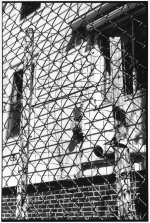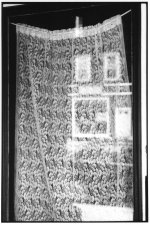colinh said:
OK, I just have to ask this just once:
Which film, exposed and developed how, which enlarger, which paper, exposed and developed how?
colin
Are you prepared to pay for my divulging of secrets? That XPAN 30 in the classifieds will do the trick
😀
The images I print at this size are from those 'perfect' negatives- the times when everything comes together by chance or my attempts to make it happen. More often chance is the reason- despite my best attempts at getting it right. And I am working hard at a new combo of film/developer/dilution now trying to make this happen more.
But here it goes- M7 with 50 Summicron (latest version). FP4+ rated at 125. f8 or 11 as I recall, handheld at about 1/250 or 1/125. B+W 021 light yellow filter, multicoated version. Hood in use.
Negative shot on April 14, 2006. I mention this because the light here is very different at different times of the year- the clear, low humidity days full sun in April is beautiful. Shot in the morning- 10ish? 11 at the latest.
Developed in HC-110b 10 minutes at 70°F. Metal tank & reels. This was likely run in a 4-reel tank, as I show 6 rolls shot in that 2 day period. I agitate by the inversion method- turning the tank upside down and then right side up with a 1/4 to 1/2 turn each way, back and forth. Developer is poured in, no pre-wet, the timer is started and I agitate for 30 seconds, then 5 inversions every 30 seconds. Timer ends, developer gets poured out and then stop bath, fix, rinse, fixer remover, wash & wetting agent. following the standard procedures. I use kodak indicator stop and then Sprint chemistry for the rest. (I don't think the chemistry beyond developer makes any difference, but who knows)
Films are wiped with a Photo-Wipe and air dried.
I print using a LPL Saunders 4500 VC enlarger, with Nikon glass. 1620's are made using the 50/2.8. It is the older version in the metal barrel. I also use a glass carrier for large prints- flatness is even more important as you get bigger.
Paper in this case is Oriental Seagull VC, fiber base, glossy surface. Lately I have been using the Ilford MGWA for some prints. All my proof prints are done on the Ilford MGIV fiber base, glossy.
I do split print, but not always. Most often I will split print in order to preserve a smoother gradation of tones in the whites- one main exposure at grade 1.5 or 2 and a second, very short exposure at full contrast, which on this head seems to be listed at about 5.25. This second exposure serves to set the deepest black tones all the way to a full rich black, something I find necessary in most of my images. There is often little burning and doging in these prints, again these are near perfect negatives to start with- although I almost always will do edge burns of a few seconds all the way around to help contain the image. Much of my work contains vast areas of white with fencing or wires overlapping, these edge burns seem to help give some enclosure to the image, even as the black border does this to some degree.
Prints are developed in a mix of Kodak Dektol and Selectol Soft, often with a touch of Benzotriazole 2% or Potassium Bromide 10% added to tweak color and liven the white tones- thus my lower than 'normal' contrast initial exposure. My development times range from 2 to 4 minutes- with 3 winding up the time for most prints.
I then follow the normal stop, fix, etc, steps. Prints are almost always toned before they are dried, in kodak selenium toner mixed with kodak hypo-clearing agent. My usual dilution is 200ml selenium stock per Liter of HC for the cold toned papers- For the Ilford MGWA I am still working out a final process that fits these images- I'm now leaning towards no toner or a very weak toner without color change, then a Sistan bath. I have printed on the ILMGWA since it came out and like it very much, but these images seem to me to need a colder tone paper. This is what I'm working out these days, in 1114 prints.
I come from a history of printing on graded papers- Seagull G, Portrigia, Brovira, Gallerie. I printed all the 20x24's of my previous project from 810 negatives onto Agfa Insignia (I got the last of that paper through a contact at Agfa), so developer recipies are a big part of my working in the darkroom. In those days that was all there was between Grade 2 and Grade 3, so I made quite a study of it. I've printed with Amidol, with Ultra Black, nearly all the 'big ones'. Amidol is a beautiful developer, but the extra time involved in preparation and the extended developing times (six to nine minutes) has become tiresome as I get older and my stamina for a long printing sessions wanes.
From that long winded tome to some images. I, like Magus, scan from prints, in my case the 810 proofs I spit out 20 or 25 at a time a few mornings or evenings every week.
(pardon the thumbnails, I have no hosting account) The first one is the negative described above- the second is the same film/developer combo with late summer light.



